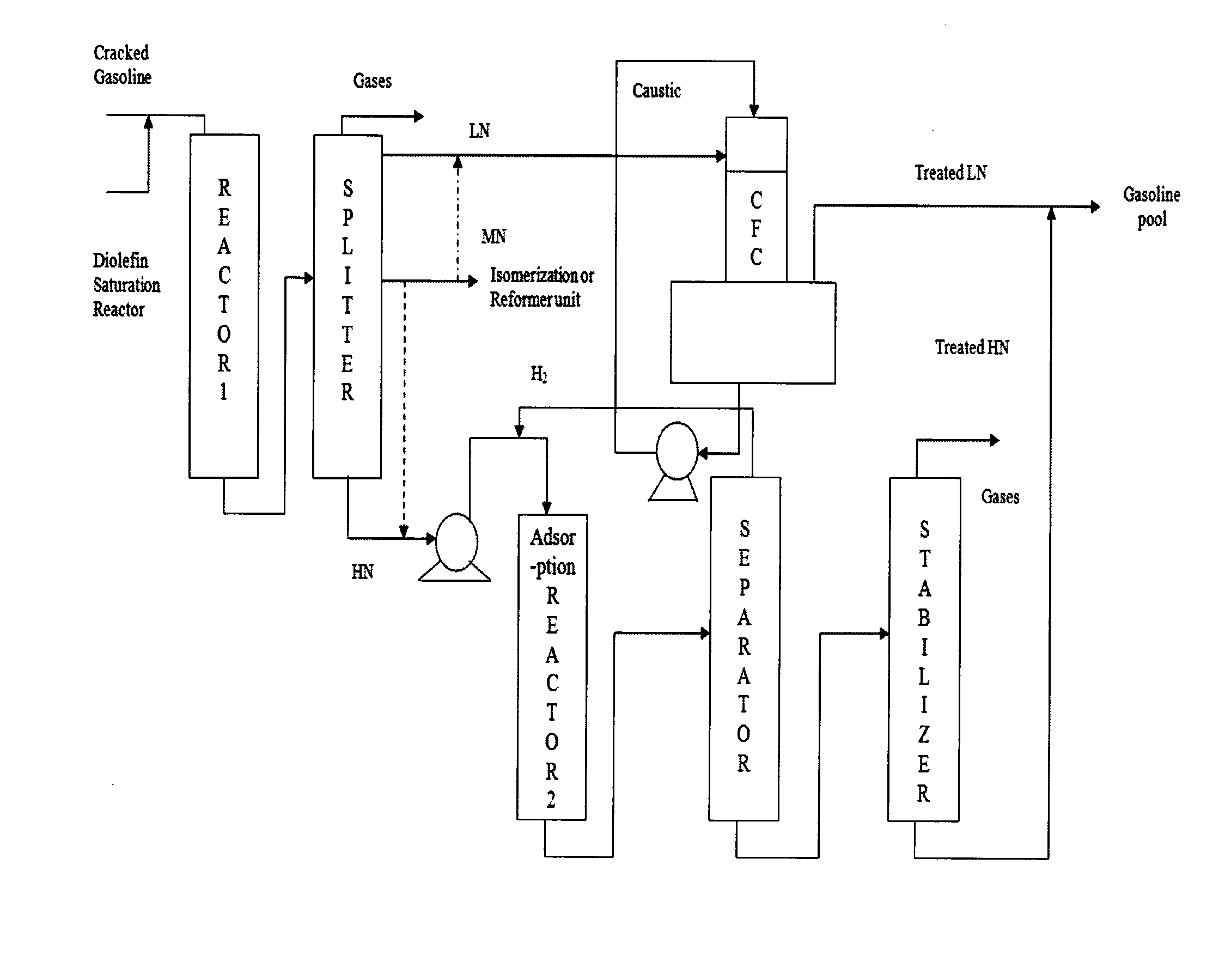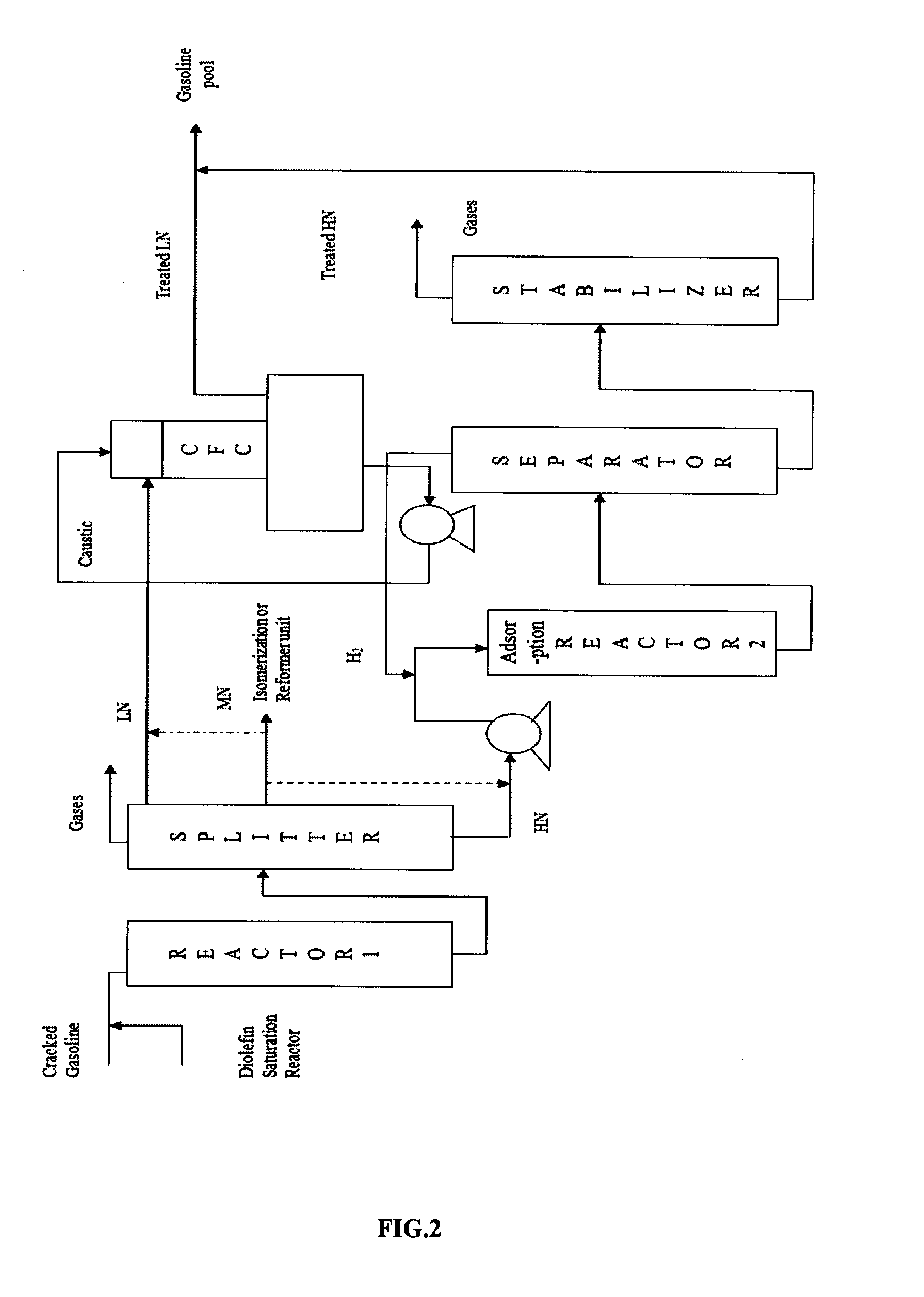Process for deep desulfurization of cracked gasoline with minimum octane loss
a technology of desulfurization and cracking, applied in the direction of hydrogen oil treatment, refining with oxygen compounds, aqueous alkaline solutions, etc., can solve the problems of not teaching deep desulfurization, high hydrogen consumption, and significant reduction of fuel octane number, so as to reduce the benzene content of the gasoline pool
- Summary
- Abstract
- Description
- Claims
- Application Information
AI Technical Summary
Benefits of technology
Problems solved by technology
Method used
Image
Examples
example-1
[0045]Full range Coker gasoline (IBP-210° C.) was pretreated for selective saturation of diolefins over a low activity CoMo or NiMo catalyst using Hydroprocessing Micro-reactor unit (MRU) of 20 cc catalyst volume. The process flow diagram of the MRU is shown in FIG. 4. This MRU contains a fixed bed reactor, which is equipped with electrical furnace, which can heat the reactor up to 500° C. The furnace is divided into three different zones. The top zone is used for preheating the feed stream before entering the process zones. The middle zone is used for process reactions and bottom zone is used for post heating purposes. Adjusting the corresponding skin temperatures controls the reactor internal temperatures. The feed was charged into a feed tank (T-1), which can preheat the feedstock up to about 100° C. The feed was then pumped through a diaphragm pump (P-1). The Mass Flow Controller for measurement of hydrogen gas is equipped in the inlet of the reactor. The liquid hydrocarbon and ...
example-2
[0046]Full range Coker gasoline (IBP-210° C.) was hydrotreated over conventional commercial HDS catalyst using Hydroprocessing Micro-reactor unit (MRU) of 20 cc catalyst volume. The hydrocarbon feed and product samples were analyzed for various properties. The details of operating parameters and feed / product properties are shown below in Table-2.
TABLE 2FeedProd-5Prod-6Prod-7Prod-8Prod-9a) OperatingParameters1. Pressure, bar30303030302. Temperature, ° C.2002503003203503. LHSV, hr−12.52.52.52.52.54. H2 / HC ratio, Nm3 / m3200200200200200b) Feed product properties1. Total Sulfur, ppm290025009115550402. Mercaptan Sulphur, ppm4277671240003. Density @ 15° C. (g / cc)0.71910.7120.71050.7090.70850.7084. Sim. TBP (ASTM D-2887)Weight %Temp., ° C.IBP55.454.253.953.255.353.2 556.958.355.85656.7561057.765.458.657.157.4573068.478.870.568.668.768.25089.995.893.288.587.986.670104.2101.4102102.2101.9101.390126.0108.8123.2124.6124.9124.195146.8138.2135.8142.7137.9137.5FBP204.5203.3204.2202.4201.5201.35. Ol...
example-3
[0047]Full range Coker gasoline (IBP-210° C.) was split into three cuts i.e. Light Cut (IBP-70° C.), intermediate Cut (70-90° C.) and (90-210° C.) using TBP distillation apparatus. The light cut containing about 80% high octane value olefins and sulfur in the form of mercaptans is desulfurized with caustic treatment using Continuous Film Contactor (CFC). The process flow diagram of CFC is shown in FIG. 5. In CFC, the hydrocarbon and the caustic or amine streams are fed separately through a two stage distributor to the contacting device with uniformly packed and specially treated and shaped longitudinal SS wires. These wires are preferentially wetted by aqueous stream. In this process, an enormous interfacial surface area of contact is created without using any dispersive energy, which makes this device highly efficient. Thus, separation of the phases following the contacting is achieved with much ease and without any entrainment.
[0048]Intermediate Cut was also desulfurized with caus...
PUM
| Property | Measurement | Unit |
|---|---|---|
| temperature | aaaaa | aaaaa |
| pressure | aaaaa | aaaaa |
| temperature | aaaaa | aaaaa |
Abstract
Description
Claims
Application Information
 Login to View More
Login to View More - R&D
- Intellectual Property
- Life Sciences
- Materials
- Tech Scout
- Unparalleled Data Quality
- Higher Quality Content
- 60% Fewer Hallucinations
Browse by: Latest US Patents, China's latest patents, Technical Efficacy Thesaurus, Application Domain, Technology Topic, Popular Technical Reports.
© 2025 PatSnap. All rights reserved.Legal|Privacy policy|Modern Slavery Act Transparency Statement|Sitemap|About US| Contact US: help@patsnap.com



